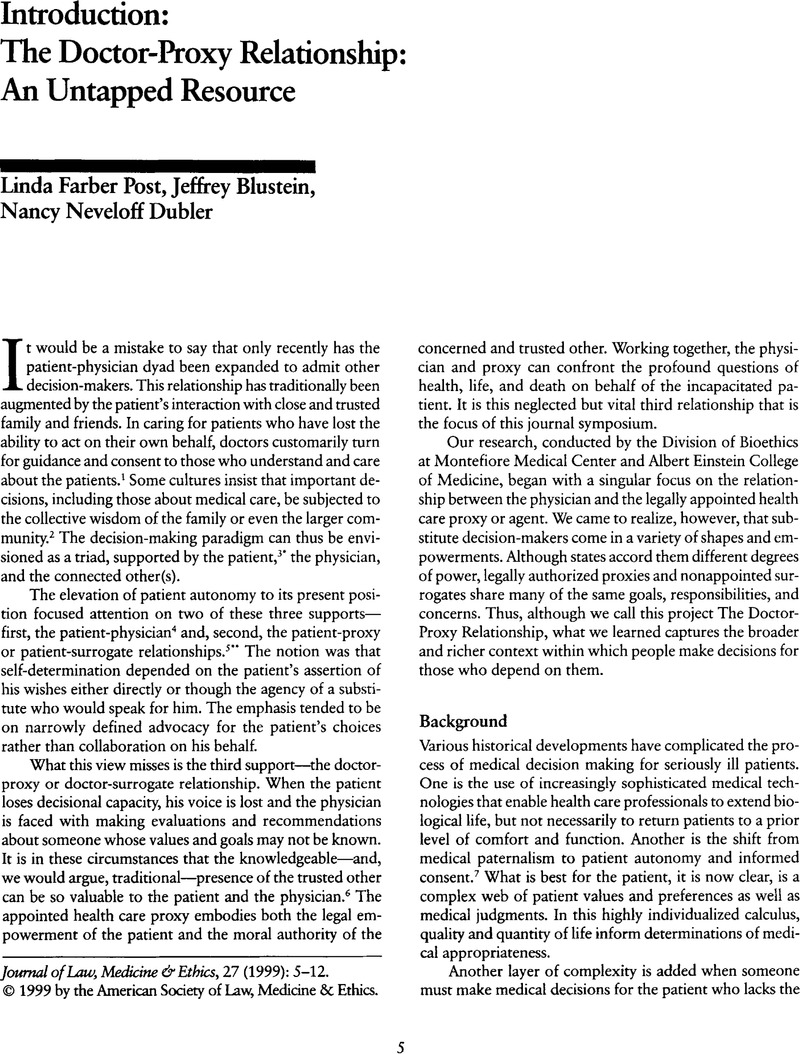Crossref Citations
This article has been cited by the following publications. This list is generated based on data provided by Crossref.
Logan, Wayne A.
1999.
Declaring life at the crossroads of death: Victims’ anti‐death penalty views and prosecutors’ charging decisions.
Criminal Justice Ethics,
Vol. 18,
Issue. 2,
p.
41.
Levine, Carol
and
Zuckerman, Connie
2000.
Hands On/Hands Off: Why Health Care Professionals Depend on Families but Keep Them at Arm's Length.
Journal of Law, Medicine & Ethics,
Vol. 28,
Issue. 1,
p.
5.
Koch, Tom
2001.
Future states: the axioms underlying prospective, future-oriented, health planning instruments.
Social Science & Medicine,
Vol. 52,
Issue. 3,
p.
453.
HICKMAN, SUSAN E.
2002.
Improving Communication Near the End of Life.
American Behavioral Scientist,
Vol. 46,
Issue. 2,
p.
252.
Akabayashi, Akira
Slingsby, Brian Taylor
and
Kai, Ichiro
2003.
Perspectives on advance directives in Japanese society: A population-based questionnaire survey.
BMC Medical Ethics,
Vol. 4,
Issue. 1,
Kapp, Marshall B.
2003.
Geriatric Medicine.
p.
1221.
Kapp, Marshall B.
2007.
Practice of Geriatrics.
p.
61.
Kapp, M.B.
2007.
Encyclopedia of Gerontology.
p.
526.
Bernat, James L.
2008.
Dementias.
Vol. 89,
Issue. ,
p.
121.
Frierson, Richard L.
and
Jacoby, Katherine A.
2008.
Dementias.
Vol. 89,
Issue. ,
p.
113.
Bernat, James L.
2008.
Disorders of Consciousness.
Vol. 90,
Issue. ,
p.
369.
Reckrey, Jennifer M.
Diane McKee, M.
Sanders, Justin J.
and
Lipman, Hannah I.
2011.
Resident Physician Interactions with Surrogate Decision‐Makers: The Resident Experience.
Journal of the American Geriatrics Society,
Vol. 59,
Issue. 12,
p.
2341.
Torke, Alexia M.
Petronio, Sandra
Sachs, Greg A.
Helft, Paul R.
and
Purnell, Christianna
2012.
A conceptual model of the role of communication in surrogate decision making for hospitalized adults.
Patient Education and Counseling,
Vol. 87,
Issue. 1,
p.
54.
Jenerette, Coretta M.
and
Mayer, Deborah K.
2016.
Patient-Provider Communication: the Rise of Patient Engagement.
Seminars in Oncology Nursing,
Vol. 32,
Issue. 2,
p.
134.
Hickman, Susan E.
Torke, Alexia M.
Heim Smith, Nicholette
Myers, Anne L.
Sudore, Rebecca L.
Hammes, Bernard J.
and
Sachs, Greg A.
2021.
Reasons for discordance and concordance between POLST orders and current treatment preferences.
Journal of the American Geriatrics Society,
Vol. 69,
Issue. 7,
p.
1933.





